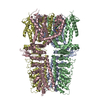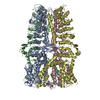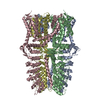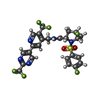+ Open data
Open data
- Basic information
Basic information
| Entry | Database: PDB / ID: 6wj5 | ||||||
|---|---|---|---|---|---|---|---|
| Title | Structure of human TRPA1 in complex with inhibitor GDC-0334 | ||||||
 Components Components | Transient receptor potential cation channel subfamily A member 1 | ||||||
 Keywords Keywords | MEMBRANE PROTEIN/Inhibitor / TRPA1 / channel / inhibitor / antagonist / MEMBRANE PROTEIN / MEMBRANE PROTEIN-Inhibitor complex | ||||||
| Function / homology |  Function and homology information Function and homology informationregulation of blood circulation / positive regulation of monoatomic anion transport / cellular response to food / temperature-gated cation channel activity / regulation of neuronal action potential / cellular response to carbon dioxide / osmolarity-sensing monoatomic cation channel activity / stereocilium bundle / detection of chemical stimulus involved in sensory perception of pain / urinary bladder smooth muscle contraction ...regulation of blood circulation / positive regulation of monoatomic anion transport / cellular response to food / temperature-gated cation channel activity / regulation of neuronal action potential / cellular response to carbon dioxide / osmolarity-sensing monoatomic cation channel activity / stereocilium bundle / detection of chemical stimulus involved in sensory perception of pain / urinary bladder smooth muscle contraction / thermoception / cellular response to toxic substance / cellular response to caffeine / response to pain / TRP channels / calcium ion transmembrane import into cytosol / cellular response to cold / intracellularly gated calcium channel activity / detection of mechanical stimulus involved in sensory perception of pain / positive regulation of insulin secretion involved in cellular response to glucose stimulus / voltage-gated calcium channel activity / monoatomic ion transport / sensory perception of pain / response to cold / calcium ion transmembrane transport / calcium channel activity / cellular response to hydrogen peroxide / intracellular calcium ion homeostasis / cellular response to heat / channel activity / protein homotetramerization / cell surface receptor signaling pathway / apical plasma membrane / response to xenobiotic stimulus / axon / identical protein binding / plasma membrane Similarity search - Function | ||||||
| Biological species |  Homo sapiens (human) Homo sapiens (human) | ||||||
| Method | ELECTRON MICROSCOPY / single particle reconstruction / cryo EM / Resolution: 3.6 Å | ||||||
 Authors Authors | Rohou, A. / Rouge, L. / Arthur, C.P. / Volgraf, M. / Chen, H. | ||||||
 Citation Citation |  Journal: J Exp Med / Year: 2021 Journal: J Exp Med / Year: 2021Title: A TRPA1 inhibitor suppresses neurogenic inflammation and airway contraction for asthma treatment. Authors: Alessia Balestrini / Victory Joseph / Michelle Dourado / Rebecca M Reese / Shannon D Shields / Lionel Rougé / Daniel D Bravo / Tania Chernov-Rogan / Cary D Austin / Huifen Chen / Lan Wang / ...Authors: Alessia Balestrini / Victory Joseph / Michelle Dourado / Rebecca M Reese / Shannon D Shields / Lionel Rougé / Daniel D Bravo / Tania Chernov-Rogan / Cary D Austin / Huifen Chen / Lan Wang / Elisia Villemure / Daniel G M Shore / Vishal A Verma / Baihua Hu / Yong Chen / Laurie Leong / Chris Bjornson / Kathy Hötzel / Alvin Gogineni / Wyne P Lee / Eric Suto / Xiumin Wu / John Liu / Juan Zhang / Vineela Gandham / Jianyong Wang / Jian Payandeh / Claudio Ciferri / Alberto Estevez / Christopher P Arthur / Jens Kortmann / Ryan L Wong / Jose E Heredia / Jonas Doerr / Min Jung / Jason A Vander Heiden / Merone Roose-Girma / Lucinda Tam / Kai H Barck / Richard A D Carano / Han Ting Ding / Bobby Brillantes / Christine Tam / Xiaoying Yang / Simon S Gao / Justin Q Ly / Liling Liu / Liuxi Chen / Bianca M Liederer / Joseph H Lin / Steven Magnuson / Jun Chen / David H Hackos / Justin Elstrott / Alexis Rohou / Brian S Safina / Matthew Volgraf / Rebecca N Bauer / Lorena Riol-Blanco /  Abstract: Despite the development of effective therapies, a substantial proportion of asthmatics continue to have uncontrolled symptoms, airflow limitation, and exacerbations. Transient receptor potential ...Despite the development of effective therapies, a substantial proportion of asthmatics continue to have uncontrolled symptoms, airflow limitation, and exacerbations. Transient receptor potential cation channel member A1 (TRPA1) agonists are elevated in human asthmatic airways, and in rodents, TRPA1 is involved in the induction of airway inflammation and hyperreactivity. Here, the discovery and early clinical development of GDC-0334, a highly potent, selective, and orally bioavailable TRPA1 antagonist, is described. GDC-0334 inhibited TRPA1 function on airway smooth muscle and sensory neurons, decreasing edema, dermal blood flow (DBF), cough, and allergic airway inflammation in several preclinical species. In a healthy volunteer Phase 1 study, treatment with GDC-0334 reduced TRPA1 agonist-induced DBF, pain, and itch, demonstrating GDC-0334 target engagement in humans. These data provide therapeutic rationale for evaluating TRPA1 inhibition as a clinical therapy for asthma. | ||||||
| History |
|
- Structure visualization
Structure visualization
| Movie |
 Movie viewer Movie viewer |
|---|---|
| Structure viewer | Molecule:  Molmil Molmil Jmol/JSmol Jmol/JSmol |
- Downloads & links
Downloads & links
- Download
Download
| PDBx/mmCIF format |  6wj5.cif.gz 6wj5.cif.gz | 743.6 KB | Display |  PDBx/mmCIF format PDBx/mmCIF format |
|---|---|---|---|---|
| PDB format |  pdb6wj5.ent.gz pdb6wj5.ent.gz | 626.2 KB | Display |  PDB format PDB format |
| PDBx/mmJSON format |  6wj5.json.gz 6wj5.json.gz | Tree view |  PDBx/mmJSON format PDBx/mmJSON format | |
| Others |  Other downloads Other downloads |
-Validation report
| Summary document |  6wj5_validation.pdf.gz 6wj5_validation.pdf.gz | 1.2 MB | Display |  wwPDB validaton report wwPDB validaton report |
|---|---|---|---|---|
| Full document |  6wj5_full_validation.pdf.gz 6wj5_full_validation.pdf.gz | 1.3 MB | Display | |
| Data in XML |  6wj5_validation.xml.gz 6wj5_validation.xml.gz | 62.5 KB | Display | |
| Data in CIF |  6wj5_validation.cif.gz 6wj5_validation.cif.gz | 96.9 KB | Display | |
| Arichive directory |  https://data.pdbj.org/pub/pdb/validation_reports/wj/6wj5 https://data.pdbj.org/pub/pdb/validation_reports/wj/6wj5 ftp://data.pdbj.org/pub/pdb/validation_reports/wj/6wj5 ftp://data.pdbj.org/pub/pdb/validation_reports/wj/6wj5 | HTTPS FTP |
-Related structure data
| Related structure data |  21688MC M: map data used to model this data C: citing same article ( |
|---|---|
| Similar structure data |
- Links
Links
- Assembly
Assembly
| Deposited unit | 
|
|---|---|
| 1 |
|
- Components
Components
| #1: Protein | Mass: 72622.125 Da / Num. of mol.: 4 Source method: isolated from a genetically manipulated source Source: (gene. exp.)  Homo sapiens (human) / Gene: TRPA1, ANKTM1 / Production host: Homo sapiens (human) / Gene: TRPA1, ANKTM1 / Production host:  #2: Chemical | ChemComp-LXY / ( Has ligand of interest | Y | |
|---|
-Experimental details
-Experiment
| Experiment | Method: ELECTRON MICROSCOPY |
|---|---|
| EM experiment | Aggregation state: PARTICLE / 3D reconstruction method: single particle reconstruction |
- Sample preparation
Sample preparation
| Component | Name: TRPA1 bound by inhibitor GDC-0334 / Type: COMPLEX / Entity ID: #1 / Source: RECOMBINANT | |||||||||||||||||||||||||
|---|---|---|---|---|---|---|---|---|---|---|---|---|---|---|---|---|---|---|---|---|---|---|---|---|---|---|
| Molecular weight | Units: MEGADALTONS / Experimental value: NO | |||||||||||||||||||||||||
| Source (natural) | Organism:  Homo sapiens (human) Homo sapiens (human) | |||||||||||||||||||||||||
| Source (recombinant) | Organism:  | |||||||||||||||||||||||||
| Buffer solution | pH: 8.2 | |||||||||||||||||||||||||
| Buffer component |
| |||||||||||||||||||||||||
| Specimen | Conc.: 0.33 mg/ml / Embedding applied: NO / Shadowing applied: NO / Staining applied: NO / Vitrification applied: YES | |||||||||||||||||||||||||
| Specimen support | Details: Grid was gold-coated. Glow discharge using GloQube, negative polarity. Grid material: COPPER / Grid type: C-flat-2/1 | |||||||||||||||||||||||||
| Vitrification | Instrument: FEI VITROBOT MARK IV / Cryogen name: ETHANE / Humidity: 100 % / Chamber temperature: 277 K / Details: 2 x 4s blot time |
- Electron microscopy imaging
Electron microscopy imaging
| Experimental equipment |  Model: Titan Krios / Image courtesy: FEI Company |
|---|---|
| Microscopy | Model: FEI TITAN KRIOS |
| Electron gun | Electron source:  FIELD EMISSION GUN / Accelerating voltage: 300 kV / Illumination mode: FLOOD BEAM FIELD EMISSION GUN / Accelerating voltage: 300 kV / Illumination mode: FLOOD BEAM |
| Electron lens | Mode: BRIGHT FIELD / Nominal magnification: 130000 X / Cs: 2.7 mm / C2 aperture diameter: 70 µm / Alignment procedure: COMA FREE |
| Specimen holder | Cryogen: NITROGEN / Specimen holder model: FEI TITAN KRIOS AUTOGRID HOLDER |
| Image recording | Average exposure time: 10 sec. / Electron dose: 47.5 e/Å2 / Detector mode: COUNTING / Film or detector model: GATAN K2 QUANTUM (4k x 4k) / Num. of grids imaged: 1 |
| EM imaging optics | Energyfilter name: GIF Bioquantum / Energyfilter slit width: 20 eV |
| Image scans | Sampling size: 5 µm / Movie frames/image: 40 / Used frames/image: 1-40 |
- Processing
Processing
| EM software |
| ||||||||||||||||||||||||||||||
|---|---|---|---|---|---|---|---|---|---|---|---|---|---|---|---|---|---|---|---|---|---|---|---|---|---|---|---|---|---|---|---|
| CTF correction | Type: PHASE FLIPPING AND AMPLITUDE CORRECTION | ||||||||||||||||||||||||||||||
| Particle selection | Num. of particles selected: 4114800 Details: 15,630 movies were selected because of the quality of their CTF fits. 4,114,800 coordinates were selected, leading to 466,632 particles which clustered into high-quality 2D class averages | ||||||||||||||||||||||||||||||
| Symmetry | Point symmetry: C4 (4 fold cyclic) | ||||||||||||||||||||||||||||||
| 3D reconstruction | Resolution: 3.6 Å / Resolution method: FSC 0.143 CUT-OFF / Num. of particles: 58836 / Algorithm: FOURIER SPACE Details: Data at spatial frequencies higher than 1/4.8 A-1 were not used during any part of the refinement. Num. of class averages: 1 / Symmetry type: POINT | ||||||||||||||||||||||||||||||
| Atomic model building | Protocol: AB INITIO MODEL / Space: REAL Details: CCG MOE was used for refinement after Phenix real-space refinement. | ||||||||||||||||||||||||||||||
| Atomic model building | PDB-ID: 3J9P Accession code: 3J9P / Source name: PDB / Type: experimental model |
 Movie
Movie Controller
Controller











 PDBj
PDBj




